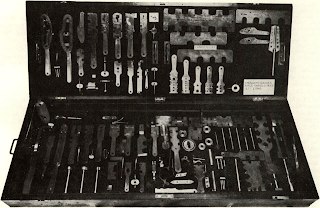While Burton preferred the Enfield, the Springfield
super-accurate aiming. As some stocks had been
More common an example of the Fayetteville rifle
One or two examples of pistol-carbines are found
arms, and a special hammer of rather straight form,
Richmond and Fayetteville supplied the majority of
The decision to use brass, valuable for percussion
super-accurate aiming. As some stocks had been
More common an example of the Fayetteville rifle
One or two examples of pistol-carbines are found
arms, and a special hammer of rather straight form,
Richmond and Fayetteville supplied the majority of
The decision to use brass, valuable for percussion
 |
Extensive gauging was to be introduced in South’s production scheme by Macon Enfield factory. Gauge set shown is from
|

Comments
Post a Comment